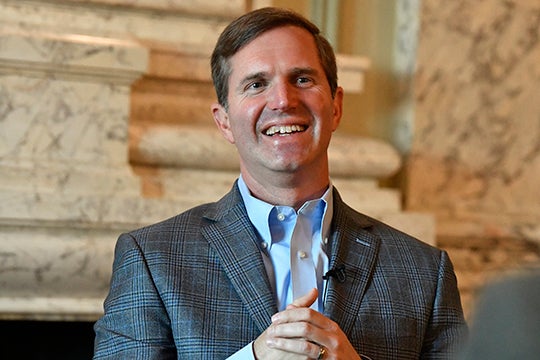Beshear unveils executive branch budget
Published 8:05 am Monday, December 18, 2023

- Kentucky Governor Andy Beshear reacts to a question sits for his first interview following his re-election in the Kentucky Governors race in the State Reception Room at the Kentucky State Capitol Frankfort, Ky., Wednesday, Nov. 8, 2023. Beshear defeated Attorney General Daniel Cameron to retain the Governorship. (AP Photo/Timothy D. Easley)
Monday, Gov. Andy Beshear presented his budget proposal for the next two years.
Kentucky is in a unique financial position after three consecutive years of record-setting budget surpluses, an influx of federal COVID relief dollars and new sources of recurring revenue, like sports betting.
Beshear wants to use the opportunity to invest in Kentucky’s future, through historic investments in public education, childcare, infrastructure and economic development.
Why so early?
Beshear is presenting his budget proposal earlier than in previous years to avoid a repeat of last session.
Last year, for the first time in Kentucky history, House Republicans introduced their budget proposal before Beshear got a chance.
Beshear said that is not only contrary to state law, but also bad procedure that leaves out important budget items.
“The driving purpose with me unveiling our budget so early is hoping as many of these important things get in the House’s budget when they submit it at the beginning of the session,” Beshear said at a Monday morning budget briefing.
“… Being the head of the executive branch, having an entire budget office that works on this for two years ahead of time, we’re in the best position to give the first initial proposal.”
Beshear proposed a $136.6 billion budget for the executive branch, the largest in state history. It includes $33.5 billion of state spending. The rest comes from federal funding and other outside revenue sources.
Beshear’s proposed budget does not touch the state’s Budget Reserve Trust Fund, referred to as the “rainy day fund.”
The governor’s budget is “structurally responsible,” meaning it matches recurring revenues with recurring expenses and one-time revenues with one-time expenses, while spending less than the state brings in.
According to the independent Consensus Revenue Forecasting Group, a group of nine economic and financial experts, the state is expected to bring in approximately $47 billion in General Fund revenues in FY24 through FY26.
This compares to the $33.5 billion that the state would spend in the FY24-26 executive budget under Beshear’s proposal.
Beshear’s budget spans a broad array of items, from school employee raises to high-speed internet, but there are a few highlights.
Education
Beshear’s education plan doesn’t include any surprises, since he revealed most of it on the campaign trail this fall.
It includes an 11% across-the-board raise for public school employees, as well as a fully-funded teachers’ pension paired with no health insurance premium increases for school employees.
The raises are included in the SEEK budget, as well as a 4% increase in per-pupil funding in the SEEK formula, which determines how much state funding each school district receives.
Beshear’s budget fully funds student transportation, a $124 million cost per year.
Other education priorities include another $100 million pool for career and technical education facilities, restoration of a teacher student loan forgiveness program and funds to address social emotional learning and mental health.
K-12 and postsecondary education combined make up 30% of the overall budget, and 49% of all state fund appropriations.
Postsecondary education budget items include an 8% increase in base funding to Kentucky’s nine public institutions after recent cuts and nearly $100 million total for new student loan forgiveness programs in key worker shortage areas, including teachers, social workers and state employees.
Childcare
Beshear’s budget includes $172 million each year for universal pre-K for Kentucky’s 4-year olds.
This would not only allow about 34,000 additional 4-year-olds to get a preschool education preparing them for kindergarten, but free up several thousand childcare slots, which are currently very limited.
Beshear presented a three-component initiative for child care assistance. First, his budget would use $40 million each year to maintain the current Child Care Assistance Program’s per day provider reimbursement rate after federal funds expire.
Second, universal pre-K would free up about $13 million in federal funds that could be then used for kids aged 0-3 in the CCAP program. Third, a total of $35 million across the biennium would be used to incentivize private child care facilities to open up more spots.
Public Safety and Jails
Beshear’s budget provides another $2,500 pay increase for Kentucky State Police in FY25, followed by an inflation adjustment in FY26, while providing funding for 150 more troopers over the biennium.
It also funds the creation of two female-only juvenile detention centers in Fayette County and Western Kentucky, as well as other facility improvements for safety and separation of boys and girls and high and low-level offenders.
Health
Medicaid is fully funded in Beshear’s budget. It makes up 29.1% of the overall budget, and 16.8% of the state appropriations.
Economic Development
The budget includes funds for the Kentucky Product Development Initiative, which helps counties create “build-ready” sites for prospective businesses, as well as a “closing fund” for unforeseen needs to close the deal.
This is combined with a talent attraction media campaign to recruit a high-quality workforce to Kentucky.
Infrastructure
Beshear plans to continue investing in the Better Kentucky Cleaner Water Program with $500 million in FY25 for water and wastewater projects.
There is a $300 million pool of money that the state can use to match federal funds to complete major transportation projects, like it did with the Brent Spence Bridge.
On the campaign trail, Beshear vowed to bring high-speed internet to all Kentuckians in his second term. This budget continues that process by officially appropriating $1.1 billion in federal BEAD funds, so that Kentucky can receive the first portion of the grant.
Other priorities
There are dozens of other budget items included in Beshear’s proposal, but a few stand out.
First, Beshear’s plan would re-fund the portion of East Kentucky SAFE Fund earmarked for local government costs, like FEMA matches and lost revenue from the 2022 floods, with $75 million during the current fiscal year.
It would also add $10 million to the Affordable Housing Trust Fund, which would be the first state investment in this fund in nearly 20 years.
Second, Beshear would raise state employee salaries on a sliding scale to address pay compression.
Third, his budget would return coal severance tax revenue to coal-producing counties.
Beshear said that since he is term-limited, maybe some of the political motivations will be off the table this session and allow for more progress. He added that this is not a final product.
“I want to make sure I have the humility to say this is what we think is a really good starting place, but that doesn’t mean other people won’t have really good ideas in this process that will be worth funding,” he said.




